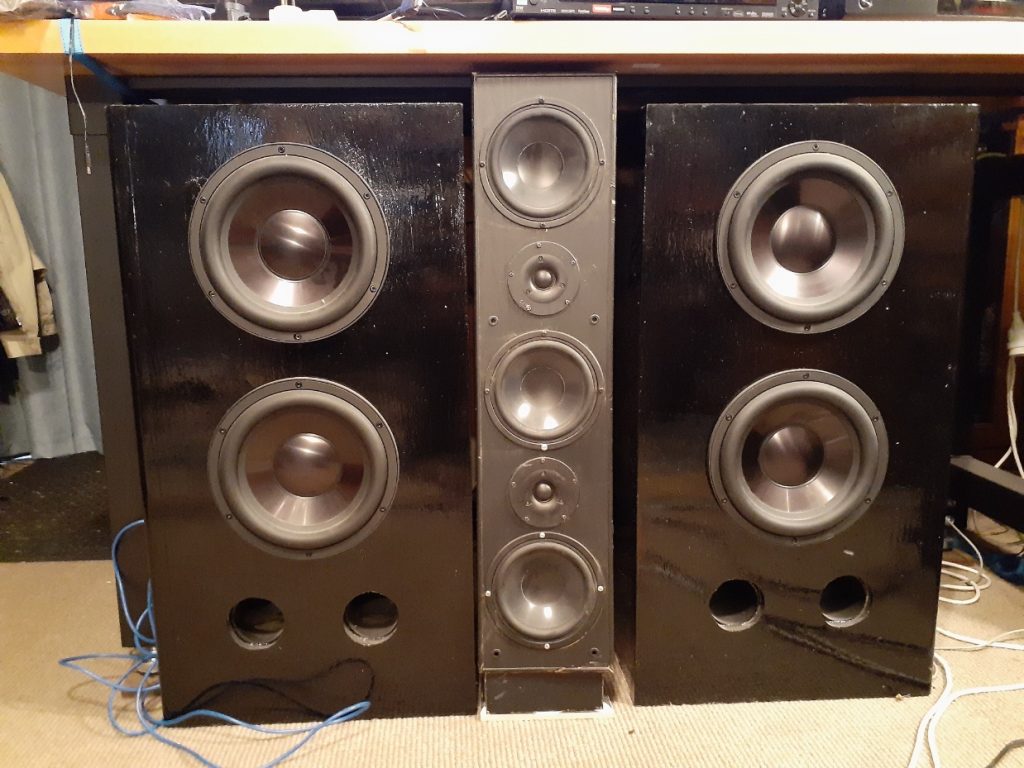
Towers of Power
Designer:
patto
Project Category:
Tower Speakers
Project Level:
Intermediate
Project Time:
20+ Hours
Project Cost:
Over $1,000
Project Description:
Full range high power main and center system
Design Goals:
o build my ultimate surround sound speaker system after 50 years of audio system building. A system to accurately and dynamically reproduce: Jazz (Armstrong to Weather Report), Rock at volume (AC/DC to Zappa), Classical (Bach to Stravinsky) including multi-channel (SACD, DVD-A etc) and Movies.
Driver Selection:
MAIN
Woofers: Dayton Audio RSS390HF-4 15″ Reference HF Subwoofer 4 Ohm (x 2)
Midrange: Peerless 850544 6-1/2″ Composite Cone CSX Woofer 8 Ohm (x 3)
Tweeters: Peerless DA25BG08-06 1″ Aluminum Dome Tweeter 6 Ohm (x 2)
CENTRE
Woofers: Dayton Audio RSS265HO-44 10″ Reference HO DVC Subwoofer (x 4)
Midranges: Peerless 850544 6-1/2″ Composite Cone CSX Woofer 8 Ohm (x 3)
Tweeters: Vifa D27TG-45-06 1″ Silk Dome Tweeter 6 Ohm (x 2). Part #264-1022 Peerless by Tymphany D27TG35-06 1″ Silk Dome Tweeter is a close equivalent.
SUBWOOFER
Dayton Audio UM18-22 18″ Ultimax DVC Subwoofer 2 ohms Per Coil
SIDE; REA; AUX SUB
Quality generic brand 12”, 6”, 1”; 6”, 1”; 15” Godzillza, all in vented enclosures.
Enclosure Design:
MAIN
Vented Bass, 225L (7.9 Cu Ft), F0 40Hz, F3 29Hz. Original design was for 2 x RSS315HFA-8 12″ for F0 30Hz but the 15s were a marginal increase in costs & they’re so much more imposing. While these are called subs they are really long excursion woofers – excellent smooth extended frequency response for a 15”.
Separate Mid/Tweeter MTMTM (renovated commercial MTM cabinet retaining 1 vent for no load with acoustic fill)
Centre
2 Vented Bass, 160L (5.65 Cu Ft), F0 28Hz, F3 24Hz.
Separate Mid/Tweeter MTMTM (renovated commercial MTM cabinet retaining vent for no load with acoustic fill)
SUB
Vented 500L (17.65 Cu Ft)
WinISD used for vented calculations.
Enclosure Assembly:
I am no carpenter so my cabs are crude work. Not pretty but extremely solid and massive.
Main Bass: Recycled 24mm (1”)) high density particle board pre-cut sheets with one laminated face (which dictated dimensions to a degree). Butt jointed, glued and screwed with a front to back brace. Gloss black acrylic paint finish.
Mid/Tweeter: Renovated commercial MTM cabinet originally with Vifa P17WJ bass/mid (used as mid only) & D25AG tweeters then renovated to MTMTM. Blew one channel’s mids (see photo) and as Vifas were unobtainable replaced all mids with Peerless because they are great speakers (couldn’t afford them 20 years ago as 4x the cost of Vifas) and required minimal cabinet mods. It was incredible timing that PE had obtained them from a warehouse clear-out!Then changed the Vifa tweeters when the Peerless were on special. That required a bit more cabinet adjustment as the magnet assembly was much bigger.
Centre Bass: Originally main bass cabs of recycled old fashion desk returns of massive construction – 35mm (1 ¾”) hi-den particle board with wood laminated face. Gloss black acrylic paint finish. The 4 x 10” woofers are overkill but I had the cabs and the speakers were on special plus discount for 4 & same shipping for 2 or 4 (a big part of cost to Australia).
Centre Mid/Tweeter are a recycled budget commercial MTM cabinet (crap drivers) recovered from a curb-side rubbish pickup). Modified to MTMTM. Replaced my original MTM using the Peerless mids but reused a pair of Vifa D27TG tweeters.
Sub – 24mm (1”) MDF, butt jointed glued & screwed with full perforated off centre brace. Gloss black acrylic paint finish.
Crossover Design:
All active using Behringer DCX2496DSP for main (300 & 3000 Hz @ 48dB, 2dB notch boost @ 30Hz), Behringer CX3400 for mid (250 & 3000 Hz @ 24dB) and sub (90 Hz @ 24dB).
Amps: Behringer Class D Inuke NU4-6000 (Main L+R Bass & Mid)), Generic Class D 50x50W (Tweeters). Behringer Class D Inuke Nu3000 (Centre Bass & Mid), Generic Class D 25x25W (1 channel per tweeter). Behringer Class D Inuke Nu3000 for subs.
Tips & Tricks:
When going full active put a polyester cap in line to the tweeters to protect from dc blurts (a distended dome assembly is not pretty). I set mine at x-over 500Hz below the active frequency. Also probably worth doing if you have low power handling mids.
Class D Amps are excellent (ignore the purest snobs) – high power/low cost and, if you use them conservatively, low distortion (repeat – ignore max power claims). I run mine at following gains: tweeters -1 o’c, mids 2 o’c, bass – 3 o’c. Only subs at max. I use the Xovers to fine tune the balance between drivers using the tweeters as 0 reference. And that extends to the X-Overs – run them at conservative gains. The high power of the class D amps provides a massive head-room for dynamic range – no compression just clean dynamic power. I would be deafened if I ever went near max power output.
After 50 years of speaker building I can only say that the way to achieve deep, accurate, low distorted and efficient bass reproduction is to use large woofers in properly sized/tuned vented enclosures. I am sorry transmission line fans, they offer no real audible or measurable advantage over a correctly sized/tuned vented except for the satisfaction of completing a complex construction (from a comparison experiment using identical woofers in optimum spec cabs).
The Dayton Audio UM18-22 18″ Ultimax DVC Subwoofer in the optimum vented cab is awesome in my very large sound room. How anybody can need 2 is beyond me.
Conclusion:
The development of this system was a combination of evolution, planning, some serendipity/events and some spare money. The sound is detailed and accurate even at high volume. They are so brutally transparent that it is easy to pick up studio/production variations track to track.
The use of low cost Class D amps was arrived at after testing – 1st the generics for rear then NU3000 for sub which was then used as bass/mid in centre as an experiment. I found them excellent and extremely cost effective (discount the claimed max power: reduce by a third for a realistic low distortion power rating).
About the Designer:
When going full active put a polyester cap in line to the tweeters to protect from dc blurts (a distended dome assembly is not pretty). I set mine at x-over 500Hz below the active frequency. Also probably worth doing if you have low power handling mids.
Class D Amps are excellent (ignore the purest snobs) – high power/low cost and, if you use them conservatively, low distortion (repeat – ignore max power claims). I run mine at following gains: tweeters -1 o’c, mids 2 o’c, bass – 3 o’c. Only subs at max. I use the Xovers to fine tune the balance between drivers using the tweeters as 0 reference. And that extends to the X-Overs – run them at conservative gains. The high power of the class D amps provides a massive head-room for dynamic range – no compression just clean dynamic power. I would be deafened if I ever went near max power output.
After 50 years of speaker building I can only say that the way to achieve deep, accurate, low distorted and efficient bass reproduction is to use large woofers in properly sized/tuned vented enclosures. I am sorry transmission line fans, they offer no real audible or measurable advantage over a correctly sized/tuned vented except for the satisfaction of completing a complex construction (from a comparison experiment using identical woofers in optimum spec cabs).
The Dayton Audio UM18-22 18″ Ultimax DVC Subwoofer in the optimum vented cab is awesome in my very large sound room. How anybody can need 2 is beyond me.
Project Parts List:
|
Part # |
Description |
Qty |
|
295-468 |
Dayton Audio RSS390HF-4 15″ Reference HF Subwoofer 4 Ohm |
1 |
|
264-1460 |
Peerless DA25BG08-06 1″ Aluminum Dome Tweeter 6 Ohm |
1 |
|
295-463 |
Dayton Audio RSS265HO-44 10″ Reference HO DVC Subwoofer |
1 |
|
295-518 |
Dayton Audio UM18-22 18″ Ultimax DVC Subwoofer 2 ohms Per Coil |
1 |
|
081-312 |
M5 x 30mm Cap Head Wood Screws Black 100 Pcs. |
1 |
|
264-1022 |
Peerless by Tymphany D27TG35-06 1″ Silk Dome Tweeter |
1 |

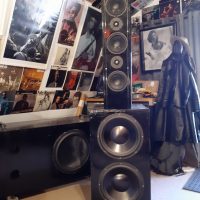
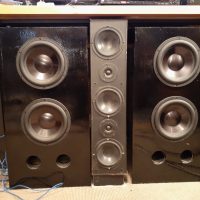
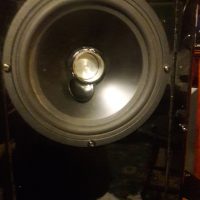
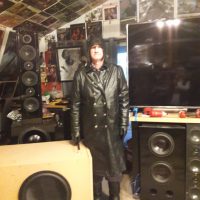
Wow-I bet those really crank!
One small suggestion to improve imaging and reduce HF phasiness: consider a MHHM configuration with the tweeters spaced as close together as possible.
Thebtweeters are more than half wavelength apart @ 3000 hz, so no phase cancellation. The MTMTM maintains phase currency in my large room. Phase cohefency was a fad in the late ’70s, measurable in an anochoic chamber but completely swamped in the real world room acoustics.